Author(s):
This theory assumes the universe it is a closed sphere inside a “shell” which holds it still preventing it from expanding or collapsing. Before big bang, the universe must have been filled with linear radiation and no mass, space was flat and time was zero (empty set). An initial big bang took place everywhere inside the shell having as purpose to curve flat space and to create mass and time. At initial moment mass got created along with all existing physical laws. Later on, stars and planets formed by gathering of mass, and then accumulated into galaxies which move randomly by curved trajectories. Inside the universe there are no lines and even light travels on long distances by curved trajectory. It cannot be an expansion of the universe since the “shell” doesn’t allow that to happen. Behaviour of curved space at subatomic level generated by the initial big bang is still happening today and this prevents all spheres of mass inside the universe from stop moving. Light coming from far distance galaxies is being curved by the behaviour of space at subatomic level at a constant linear rate with distance and time. If more time and space is given to a star, light reaching us it will shift to red even more, do to a much more curved trajectory. The universe is fixed with a constant diameter, space itself doesn’t move in any linear direction, it just curves onto itself
Present theory describes the existence and behaviour of the universe considering it as one giant sphere surrounded by a “wall” (shell) which keeps it constant. One of the major concerns regarding the universe behaviour today is related with space itself which sometimes appears to act in a flat manner (in almost all places across the known universe) and sometimes appears to behave in a curved manner (around large stars and black holes). But the physical laws that we know are valid all the time and they apply absolutely everywhere. Considering this, we have to question, if we want to measure distance, can we do it using lines or we have to use curves? For small distances like 1 or 2 meters usual we use lines but can we do the same in case of millions of light years? If at a local scale we can approximate distances by lines, the question is can we do that at universe scale? We can do an experiment to see the result. Let’s say we have 2 points in a room separated by 3 m. In order to measure the distance, two conditions are needed:
- Points do not move (they stand still) - The measuring is fast (doesn’t take 100 millions years or more) Now we look at the points and with a tape measure we can measure in 2-3 seconds the distance and we have confirmation: 3 m. At universe scale let’s say now we have two points, one on one side of the universe and the other one in a galaxy very very far away in a distant cluster on the other side of the universe. Appling the same principle with the tape measure we want to measure the distance, but we have a problem. The tape measure is made of mass and nothing in this universe exceeds the speed of light. So as I start to move the tape measure with a speed close to speed of light it still takes me many hundreds of millions of years to reach the other point. Meanwhile the points move, so the first condition is no longer valid. As I continue to measure, the second condition is also no longer valid. In this case both starting and ending point move in real time so I cannot appreciate the distance by a line. We do not live in a theoretical flat universe where using just mathematic tools can we measure things by a line. We live in a real curved universe where laws of physics constrain us so we cannot use lines to measure long distances. In conclusion, each time we measure something by a line, the distance must be small and the two points must be somehow in the same time, so in reality we are approximating curved universe as flat, exactly as we can approximate Earth as flat but only for 1-2 m, although we know the Earth is round at a scale around 10000 km or more [1].
According to what we know about the universe so far, explained in Figure1, there are mainly three stages of the universe: * From initial big bang to a stable status (fast inflation) * Standard expansion (slow inflation) * Accelerated expansion (dark energy inflation) Standard model of the universe tells us everything started from one big bang which then expanded into nothing. This model has a problem of the first and the third stage which are not in balance with the middle stage. Passing from stage 1 to stage 2 universe is causing an inflexion point and when is passing from stage 2 to stage 3 is causing an inflexion point again. Question is what is generating these inflexion points? In order to have them, something which is all around the universe must stop it from expanding and after billions years later needs to disappear in order for the universe to expand once more.
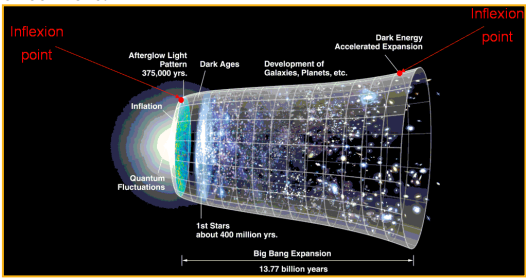
Figure 1: Expansion of universe.
Only by looking at Figure 1 we see that the central part is more or less stable on a long period of time while the left and right sides make a separate part only for a short period of time. From a mathematical point of view, if we consider these two zones errors, we should look for a way to fix these errors and complete the model in order to be more coherent with its central part. Considering this we are going to assume the universe is a sphere. There is also a “wall” everywhere around keeping it stable. There cannot be any inflation or contraction because this wall or shell doesn’t allow that to happen. But in this case we have to explain several problems like the ones below: * How the universe got created in the first second * What is Hubble constant really telling us
Our understanding about the big bang is that we have had a single point in the centre with a very high density of energy where all the future mass and radiation from the entire universe were present. The question is what was holding that point preventing from exploding one second earlier or later? Is very convenient to say time and space were created at that initial moment, but a decision is needed and action and reaction should still work in this preliminary stage. In order to avoid this problem we have to assume the universe is in fact a very large sphere with a “wall” everywhere around which is made from a continuous solid material. Before the universe got created, inside the sphere space was flat and time was absent (empty set). This large sphere was filled to maximum with linear radiation standing still. In every point the universe was at its highest temperature, the brightness was bigger than any existing star, the density of radiation was maximum and there was no mass. At the moment of the big bang, two worlds or zones got created and separated forever: * This side (made of spheres where only mass can exist) * The other side (made of reversed spheres where only radiation can exist) On this side of the universe time is 1 second every second, but on the other side time remains absent like it was before the universe got created. That is why we say at the speed of light there is no time and at quantum level everything happens in an instant. The creation of universe in the initial moment can be seen in Figure 2. Inside the “shell” it was not only one explosion in the centre expanding in all directions, but there were billions of many billions of tiny little explosions all of the same power, one near the other, all exploding in the same time. The purpose of these explosions is to increase pressure and by doing so to collapse linear radiation into spheres creating mass. In this manner mass is created in the initial fraction of universe existence. Between each 8 explosions, one sphere of mass got created [2].
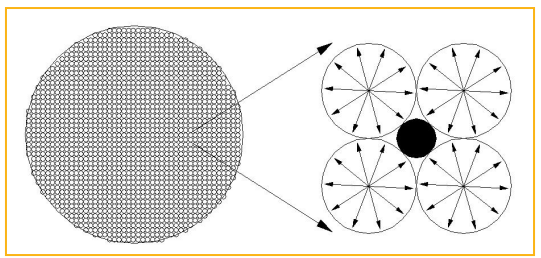
Figure 2: Creation of universe by billions of small big bangs (Black sphere is mass).
Any sphere of mass is in fact 100% made of linear radiation collapsed into a spherical shape and is surrounded by a reversed sphere made of radiation which prevents it from exploding back, pressing on its surface with a force E=mc2. If a sphere is an object which has a maximum volume while having a minimum exterior surface, a reversed sphere is an object which has a minimum volume while having a maximum exterior surface like you can see in Figure 3.
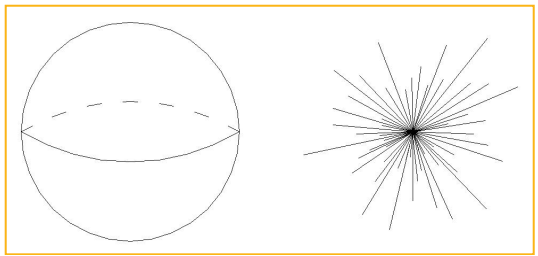
Figure 3: Sphere and reversed sphere.
The two zones of the universe have “mirrored” properties as in Table 1.
| This side | The other side |
| Only spheres can exist | Only reversed spheres can exist |
| Mass | Radiation |
| Time is 1 s/s | Time is zero (0) |
| Elements stay concentrated around a centre | Elements have a distributed behaviour with no centre |
Table 1: Properties of the two zones of the universe.
If the initial big bang actually happened everywhere inside the entire universe, it means nothing moved or expanded which solves the problem of the first inflection point. As the universe become curved from flat, now all things inside start to move based on several forces like the initial kick of the big bang, gravity of each sphere, previous collisions etc, but the main trigger which fuels the movement of the entire mass from the universe is the initial big bang which is still happening today. This giant explosion which happened everywhere can still be found at subatomic level, at quantum scale, trying to go somewhere. But since we are in a closed environment it has no place to go, so in stead, it just curves the universe onto itself. By this manner a three dimension trajectory of a sphere it is allowed. In a flat universe there can be only linear movement, but in our universe we can move things in all directions by a curved trajectory because of the behaviour of space at subatomic level. Because a sphere of mass can stay only at this side of the universe, it moves (vibrates) in a circular manner around a point in such a way it always stays on this side of the universe.
In Figure 4 you can see the simulation of the two zones of the universe [3].
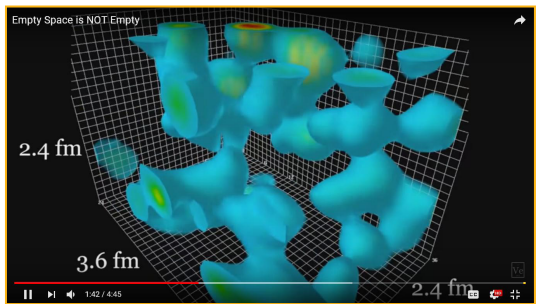
Figure 4: The two zones of the universe. In the above picture you can see with blue “the other side” where only radiation can exist. A sphere of mass will always move around itself in order to stay in the invisible area, avoiding blue area. Space around these blue volumes is a zone we can call “this side” where only mass can exist. Now we can see why light has that undulated behaviour although it travels as a line. It is because light must stay between the spheres of space of the side where only mass can exist. At origin light it is a line and wants to stay as a line, but as it travels in a curved universe, space itself at subatomic level curves light giving it its undulated characteristic. As the universe evolved, the spheres of mass gather in clouds of dust, than formed asteroids, planets, stars etc. These celestial bodies moved around inside the universe sphere in a random manner, finally being gathered under the form of galaxies which eventually established a dynamic equilibrium between themselves under the form of large structures as clusters and filaments [4].
light coming from far distance galaxies it shifts to red. If we look at even far distance galaxies they also shift to red, but more. Seeing that, Hubble concluded that the universe is expanding in a linear manner, assuming space is flat. In reality that would be the case if we were inside a flat universe, but we are in curved universe and here situation is slightly different. In a curved universe there are no lines so we cannot have a linear trajectory on long distances. For 1 or 2 m and a short period of time we can approximate things by a line, but on far distances like hundreds of thousand of light years and a long period of time it is impossible to approximate things after a line. A beam of light coming at us after millions of years only appears it has travelled in a linear manner, but in reality space curved it indefinitely. The speed and direction these curved process affects light is constant in space and in time and this is what the Hubble constant really measures. You can see in Figure 5 the trajectory of light coming from a far distance galaxy reaching our telescope after millions of years [5].
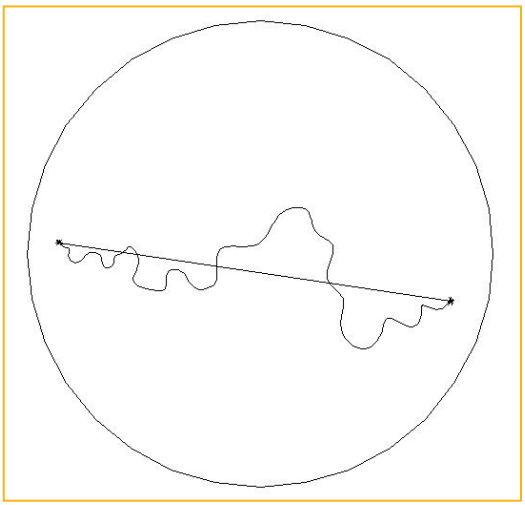
Figure 5 : Trajectory of light in a curved universe is a curve. In reality the Hubble constant tells us one major thing: the ratio between the linear trajectory of the light in a flat universe and the real curved trajectory in a curved universe is always constant. If we have lets say Line 1 and Curved 1 in case of Star 1, the ratio will be the same for all the stars, so Hubble constant would be like this: Hct = L1/C1 = L2/C2 = L3/C3. On short distances like in our solar system or even our galaxy, light doesn’t curve that much so we can see it and measure it. But for far distance galaxies the effect is clearer. The higher is the distance from the star, more time it will get for light to reach Earth, so space at subatomic level will curve it, but with the same ratio. This is evidence that the universe curves onto itself in every single point with the same amount, for each second passing by, and by doing so it must have the same curvature in all points [6].
The universe is a sphere surrounded by a solid “wall”. Before the universe got created space was flat and time was zero (Ø). At the initial moment of the big bang there was not one giant explosion moving into nothing, but there were a series of small big bangs all happening in the same time, all covering the entire universe.
All mass in the universe got created in the initial moment of the big bang. At initial moment two zones of the universe got created: “this side” where can be placed only spheres of mass and “the other side” where can be placed only reversed spheres of radiation. After the universe got created space is curved and time is 1 s/s for “this side” where we can have only mass and time remains zero (Ø) for “the other side” where we can have only radiation. The absence of time on the other side explains also another property of light which never accelerates from 0 m/s to 300 000 km/s, but it flies through space at the maximum speed from the initial moment when it is created [7].
I dedicate this article to Professor Derek Leinweber because in his theory presentation I was able to find the only thing I was looking for in the last 9 years: a description of the universe at subatomic level after the initial explosion of big bang took place [8].
